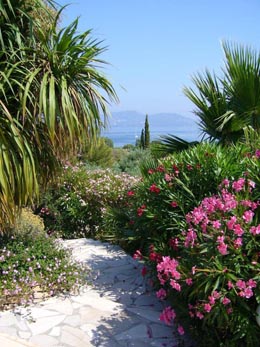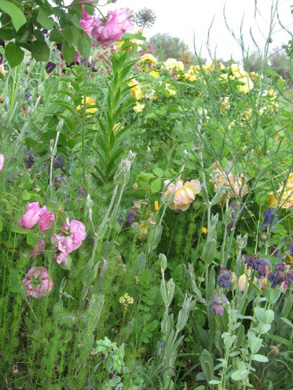Le jardin de Michel et Colette dans le Var
General Description / Description générale : Our garden, located in the Var has an area of 1 500 m². Both its configuration and its exposure to the sun and winds (mainly Mistral), led us, from the beginning, to divide the garden into several themes: the flower garden, the shrub garden, a tropical theme, a ‘Mexican’ area (in fact this is a dry garden of cacti or relatives), etc… Seven gardens in one! This landscaping of the garden allowed us to acclimatise a huge variety of species and kind of plants, including succulents, palms, perennials, ferns shade-lovers etc.
Notre jardin est situé dans le Var et s’étend sur 1500 m². Sa configuration et son exposition au soleil et au vent (principalement au Mistral), nous ont conduit dès le début à diviser le jardin en plusieurs thèmes : le jardin des fleurs, des arbustes, tropical, le jardin « Mexicain » (en fait un jardin sec de cactées ou plantes apparentées), etc … Sept jardins en un ! Ce paysagisme du jardin nous a permis d’acclimater une large variété d’espèces et de sortes de plantes : succulentes, palmiers, plantes à fleurs, fougères et plantes d’ombre, etc …
Soil and climate / Sol et climat: Here too, the situation is very contrasted. On one side of the garden, we have a slope of rocky schist. Here, there is hardly any soil to grow plants, except xerophytic plants and cacti which will root in the rock. This area, in full sun in summer, is very dry because rain runs off the rock and flows downwards. Others spots in the garden are fortunately more accommodating for growing plants, with, on the whole, a gentle and moderate climate throughout the year because of the proximity to the sea.
However, in order to protect against the wind and the summer heat, every area (except the schist slope) is regularly re-mulched and supported by several networks of watering systems.
Ici aussi, la situation est très contrastée. Sur un côté du jardin, nous avons une pente schisteuse où le rocher affleure. Il n’y a presque pas de terre pour cultiver des plantes, exceptées des Xérophytes et des cactées dont les racines d’infiltrent dans le rocher. Cette partie du jardin est en plein soleil en été et extrêmement sèche car la pluie ne s’infiltre pas dans le rocher et s’écoule en contre-bas. Heureusement, d’autres endroits du jardin sont plus accueillants et propices à la culture des plantes avec, globalement, un climat doux et tempéré tout au long de l’année en raison de la proximité de la mer.
Cependant, notamment pour tenir compte du vent et de la chaleur estivale, chaque endroit du jardin (excepté la pente schisteuse) est régulièrement recouvert de paillis et bénéficie de plusieurs réseaux d’arrosage automatique.
Plants and Projects / Plantes et projets: The character of the garden lies in the huge variety of types of plants cultivated. Our goal is to have something in bloom throughout the year, fall and winter included. The common theme is the palms, present in each part of the garden.
The garden was landscaped more than ten years ago, but during this period, we have not lived here, and our visits have been rather rare and spaced out. So, the garden is not yet mature.
La spécificité de notre jardin réside dans la grande variété des types de plantes cultivées. Le but est une constante floraison tout au long de l’année y compris en automne et en hiver. Le fil conducteur est les palmiers, omniprésents dans chaque partie du jardin.
Le jardin a maintenant plus de 10 ans. Mais durant cette période, nous n’habitions pas là et les visites furent plutôt rares et espacées. Aussi, le jardin n’est pas abouti.
Visits: The garden can be visited at any time of the year, though flowering is at its peak in spring and summer. A virtual visit is possible by looking on our website.
Appointments by email: Michel Gautier
Le jardin peut être visité à tout moment de l’année, bien que la floraison soit à son apogée au printemps et en été. En attendant, une visite virtuelle est possible sur le site web du jardin.
Rendez-vous par mail: Michel Gautier
Languages spoken: Français / English
![]()




















